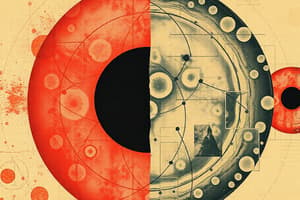Podcast
Questions and Answers
What is the primary function of the nucleus?
What is the primary function of the nucleus?
To control and coordinate the cell cycle stages
Where is ribosomal RNA produced and assembled within the nucleus?
Where is ribosomal RNA produced and assembled within the nucleus?
In the nucleolus
What is the genetic material surrounded by the nuclear envelope called?
What is the genetic material surrounded by the nuclear envelope called?
Chromatin
What happens to the nuclear envelope during mitosis?
What happens to the nuclear envelope during mitosis?
What is the role of the spindle apparatus during mitosis?
What is the role of the spindle apparatus during mitosis?
Which process involves the production of ribosomal RNA?
Which process involves the production of ribosomal RNA?
How does the nucleus manage hereditary traits during cell division?
How does the nucleus manage hereditary traits during cell division?
What is the function of chromatin within the nucleus?
What is the function of chromatin within the nucleus?
What regulatory role does the nucleus play in cellular processes?
What regulatory role does the nucleus play in cellular processes?
Explain the significance of the nucleolus in protein synthesis.
Explain the significance of the nucleolus in protein synthesis.
Flashcards are hidden until you start studying
Study Notes
Nucleus Overview
The nucleus is a central component of every cell in living organisms. It plays a vital role in regulating various processes, including growth, reproduction, and metabolism. The structure and function of nuclei vary across different types of cells due to differences in genetic material and cellular activities.
Structure
The nucleus consists of a membrane known as the nuclear envelope, which surrounds the genetic material called chromatin. Chromatin contains all the DNA and RNA required for protein synthesis. Within the nucleus, a nucleolus exists where ribosomal RNA is produced and assembled.
Function
The primary function of the nucleus is to control and coordinate the cell cycle stages, ensuring that cell division occurs smoothly. It performs this duty through its ability to transcribe genes, thus directing the production of the needed proteins for cellular growth and maintenance. Additionally, the nucleus stores the cell's complete set of genetic information and manages hereditary traits passed down from parent cells during cell division.
Reproduction and Mitosis
During mitosis, the nucleus prepares to copy itself and divide evenly between daughter cells. The nuclear envelope breaks down and the chromatin condenses. Then, the spindle apparatus aligns the duplicated genetic materials along the middle plane of the cell so that both daughter cells end up with equal sets of chromosomes. Finally, the new nucleus forms around the newly segregated chromosomes, continuing normal cellular activity.
Genetic Information Storage and Transfer
Genetic information storage happens inside the nucleus, where all of a cell's genetic information is contained. During interphase, the nucleus is active and busy making copies of the genetic information. Toward the end of interphase, the nucleus divides into two slightly smaller parts, called nucleoli. These nucleoli stay together until the cell reaches its final stage of development.
Understanding the nucleus and its roles in cellular function is essential for studying biology, particularly in understanding the relationships among structural features, molecular properties, and functional aspects of cells.
Studying That Suits You
Use AI to generate personalized quizzes and flashcards to suit your learning preferences.




